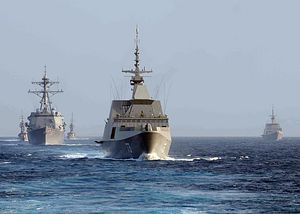Singapore’s defense budget will increase by 5.7 percent in nominal terms to $9.5 billion for fiscal year (FY) 2015, according to numbers published by the Singaporean Ministry of Finance (MOF) this week. In addition, IHS Jane’s Defence Weekly reports that defense expenditure will increase as a proportion of GDP for the first time since 2009, rising from 3.2 percent of GDP in 2014 to 3.3 percent for 2015.
This is in accordance with Singapore’s policy of gradual increases to military spending. “Our approach is to plan long-term and maintain defense expenditures steadily,” Singapore’s Minister for Defense Ng Eng Hen noted in a speech in front of the parliament at the beginning of this month.
During that speech, the defense minister also emphasized that the SAF (Singapore’s Armed Forces) needs “to re-make itself in response to a changing landscape from new security threats,” such a hybrid warfare, by stepping up investments in cyber defenses, unnamed aerial vehicles, information technology, robotics, and artificial intelligence.
The majority of ASEAN countries have failed to develop a domestic defense industry, yet Singapore is a notable exception, “with capabilities on par with international competitors,” as a McKinsey & Company study states. For example, Singapore is a Security Cooperative Participant (SCP) in the United States’ F-35A combat aircraft program and is expected to place an order this year.
The defense minister, however, emphasized, that “people remain our greatest and indispensable asset.” In the long-term the city state will suffer from a manpower shortage – Singapore has a rapidly aging population, “so each time a platform is planned, in fact, one of the key questions is how can do it with less people,” he explained during the 2015 Committee of Supply debate.
The minister further notes that the default for the Ministry of Defense and the military is to upgrade existing platforms rather than buying new ones, “unless only new equipment provides clearly superior and needed capabilities.” However, Singapore is one of the largest weapon importers in the world and it is currently actively phasing out older platforms.
Among other things, the Singaporean Navy will gradually replace its Fearless-class patrol vessels with eight new locally-built littoral mission vessels. The Navy has also ordered two new Type 218SG attack submarines from ThyssenKrupp Marine Systems, the first of which will be delivered by 2020. The army will receive new protected response vehicles, replacing the old V200. Also, Singapore will replace its fleet of Super Puma helicopters over the next decade. In 2014, Singapore also ordered six A330 tanker aircraft from Spain. Additionally between 2010 to 2014, Singapore received 32 F-15E combat aircraft from the United States and is also considering upgrading its fleet of 63 F-16 Fighting Falcons.
The twin pillars of Singapore’s defense policy are deterrence and diplomacy, according the Ministry of Defense’s website. The latter is an acknowledgement of the geostrategic limitations that the small city-state faces in a region where defense spending has increased an average of 11 percent per year over the last decade, and where China’s military spending has quadrupled over the same time span.
“Our defense relations with China are excellent, and we acknowledge China’s desire to play a peaceful and constructive role in this region,” Ng Eng Hen underlined in his speech. Yet, by 2018, Singapore will also be home to four U.S. Navy littoral combat ship (LCS), which will be rotationally deployed as part of of Washington’s pivot to Asia.

































